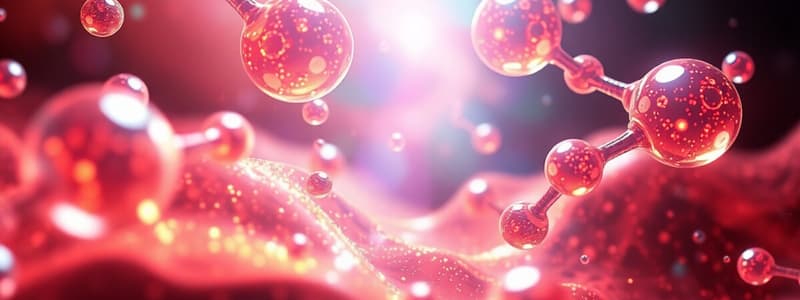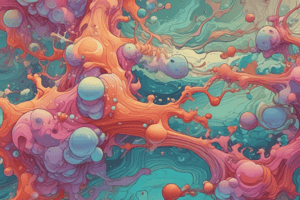Podcast
Questions and Answers
What does a low HLB value indicate about a surfactant?
What does a low HLB value indicate about a surfactant?
- It is oil soluble (correct)
- It is water soluble
- It has a high partition between phases
- It can only be used for solubilization
How is the HLB value calculated?
How is the HLB value calculated?
- HLB = %hydrophilic part/10
- HLB = %lipophilic part/10
- HLB = %hydrophilic part/5 (correct)
- HLB = %lipophilic part/5
What is the required HLB for soybean oil?
What is the required HLB for soybean oil?
- 7 ± 1 (correct)
- 5 ± 2
- 10 ± 1
- 6 ± 2
In an emulsification context, what does HLB values greater than 13 indicate?
In an emulsification context, what does HLB values greater than 13 indicate?
If cetyl alcohol makes up 25% of the oil phase, what is its percentage in the overall formula provided?
If cetyl alcohol makes up 25% of the oil phase, what is its percentage in the overall formula provided?
Why is it important to know the required HLB of an oil phase?
Why is it important to know the required HLB of an oil phase?
What happens when a surfactant has an HLB value between 6-8?
What happens when a surfactant has an HLB value between 6-8?
What is the hydrophilic part of the non-ionic surfactant example given (C10H21(OCH2CH2)6OH)?
What is the hydrophilic part of the non-ionic surfactant example given (C10H21(OCH2CH2)6OH)?
What defines the hydrophobic group of a surfactant?
What defines the hydrophobic group of a surfactant?
Why do non-polar groups have less favorable interactions in water compared to ionic or polar materials?
Why do non-polar groups have less favorable interactions in water compared to ionic or polar materials?
What occurs when surfactants are added to water?
What occurs when surfactants are added to water?
What is the effect of increasing the carbon chain length in a surfactant?
What is the effect of increasing the carbon chain length in a surfactant?
What happens to water-water attractive forces when surfactants are present at the interface?
What happens to water-water attractive forces when surfactants are present at the interface?
Why do surfactants cause a negative entropy change in water?
Why do surfactants cause a negative entropy change in water?
What primary characteristic of surfactants allows them to reduce surface tension?
What primary characteristic of surfactants allows them to reduce surface tension?
What is the required HLB of the oil phase composed of Soybean Oil and Cetyl Alcohol?
What is the required HLB of the oil phase composed of Soybean Oil and Cetyl Alcohol?
Which statement accurately describes the orientation of surfactant molecules in solution?
Which statement accurately describes the orientation of surfactant molecules in solution?
What does the variable Γ represent in the Gibbs Adsorption equation?
What does the variable Γ represent in the Gibbs Adsorption equation?
What occurs at the critical micelle concentration (cmc)?
What occurs at the critical micelle concentration (cmc)?
What occurs when the concentration of surfactants is too high?
What occurs when the concentration of surfactants is too high?
Which type of surfactants typically form micelles at lower concentrations?
Which type of surfactants typically form micelles at lower concentrations?
Which formula correctly reflects the calculation of surface excess concentration?
Which formula correctly reflects the calculation of surface excess concentration?
What defines the relationship between surface tension and bulk concentration in the context of surfactants?
What defines the relationship between surface tension and bulk concentration in the context of surfactants?
What is the effect of increasing hydrophobic chain length on cmc and micellar size?
What is the effect of increasing hydrophobic chain length on cmc and micellar size?
What effect does increasing the hydrophilic portion of a surfactant molecule have on cmc?
What effect does increasing the hydrophilic portion of a surfactant molecule have on cmc?
How can the available surface area per molecule be calculated?
How can the available surface area per molecule be calculated?
Which statement concerning the distribution of surfactants in a solution is accurate?
Which statement concerning the distribution of surfactants in a solution is accurate?
What is a characteristic of ionic micelles?
What is a characteristic of ionic micelles?
How does the presence of oxyethylene chains in non-ionic surfactants affect water structure?
How does the presence of oxyethylene chains in non-ionic surfactants affect water structure?
What is the significance of the Gibbs Adsorption equation in surfactant chemistry?
What is the significance of the Gibbs Adsorption equation in surfactant chemistry?
What happens to the aggregation number when increasing the polyoxyethylene chain in non-ionic surfactants?
What happens to the aggregation number when increasing the polyoxyethylene chain in non-ionic surfactants?
Which surfactant structure is likely to have the highest cmc according to the examples provided?
Which surfactant structure is likely to have the highest cmc according to the examples provided?
What effect does the addition of electrolytes have on ionic micelles?
What effect does the addition of electrolytes have on ionic micelles?
What happens to the solubility of ethoxylate surfactants as temperature increases?
What happens to the solubility of ethoxylate surfactants as temperature increases?
What is the Krafft point related to in surfactants?
What is the Krafft point related to in surfactants?
Why does the conductance of ionic micelles differ from that of monomers?
Why does the conductance of ionic micelles differ from that of monomers?
A larger mass counter ion impacts micellar surfaces by:
A larger mass counter ion impacts micellar surfaces by:
What is indicated by the 'cloud point temperature' in non-ionic surfactants?
What is indicated by the 'cloud point temperature' in non-ionic surfactants?
How does micellization affect the movement of ions?
How does micellization affect the movement of ions?
Flashcards
HLB (Hydrophilic-Lipophilic Balance)
HLB (Hydrophilic-Lipophilic Balance)
A measure of the balance between hydrophilic (water-loving) and lipophilic (oil-loving) properties of a surfactant.
Low HLB Surfactants
Low HLB Surfactants
Surfactants with low HLB values (1-3) are more soluble in oil and tend to form water-in-oil (w/o) emulsions.
High HLB Surfactants
High HLB Surfactants
Surfactants with high HLB values (above 13) are more soluble in water and tend to form oil-in-water (o/w) emulsions.
Solubilization
Solubilization
Signup and view all the flashcards
Wetting
Wetting
Signup and view all the flashcards
Emulsification
Emulsification
Signup and view all the flashcards
Antifoaming
Antifoaming
Signup and view all the flashcards
Required HLB
Required HLB
Signup and view all the flashcards
Amphipathic Surfactants
Amphipathic Surfactants
Signup and view all the flashcards
Hydrophobic Group
Hydrophobic Group
Signup and view all the flashcards
Hydrophilic Group
Hydrophilic Group
Signup and view all the flashcards
Hydrophobic Effect
Hydrophobic Effect
Signup and view all the flashcards
Surface Activity of Surfactants
Surface Activity of Surfactants
Signup and view all the flashcards
Surface Active Molecules
Surface Active Molecules
Signup and view all the flashcards
Surface Tension
Surface Tension
Signup and view all the flashcards
Water Structure and Solutes
Water Structure and Solutes
Signup and view all the flashcards
Critical Micelle Concentration (CMC)
Critical Micelle Concentration (CMC)
Signup and view all the flashcards
Micellization
Micellization
Signup and view all the flashcards
Surface Excess Concentration (Γ)
Surface Excess Concentration (Γ)
Signup and view all the flashcards
Gibbs Adsorption Equation
Gibbs Adsorption Equation
Signup and view all the flashcards
Dynamic Equilibrium
Dynamic Equilibrium
Signup and view all the flashcards
Effect of Counter Ion Size on CMC
Effect of Counter Ion Size on CMC
Signup and view all the flashcards
Effect of Electrolytes on CMC
Effect of Electrolytes on CMC
Signup and view all the flashcards
Cloud Point Temperature
Cloud Point Temperature
Signup and view all the flashcards
Krafft Point
Krafft Point
Signup and view all the flashcards
Conductivity Measurement and CMC
Conductivity Measurement and CMC
Signup and view all the flashcards
Electrical Conductivity of Ionic Micelles
Electrical Conductivity of Ionic Micelles
Signup and view all the flashcards
CMC (Critical Micelle Concentration)
CMC (Critical Micelle Concentration)
Signup and view all the flashcards
Micelles
Micelles
Signup and view all the flashcards
Structuring of water around hydrophobic groups
Structuring of water around hydrophobic groups
Signup and view all the flashcards
Self-aggregation
Self-aggregation
Signup and view all the flashcards
Spherical micelles
Spherical micelles
Signup and view all the flashcards
Micellar formation
Micellar formation
Signup and view all the flashcards
Micelle Aggregation Number
Micelle Aggregation Number
Signup and view all the flashcards
Study Notes
Surfactant Activity & Application
- Surfactants are amphipathic, possessing both hydrophobic (water-repelling) and hydrophilic (water-attracting) groups.
- Hydrophobic groups are typically carbon chains, while hydrophilic groups may involve ionic or polar functionalities.
- Water's high degree of structure due to hydrogen bonding is disrupted by ionic or strongly polar solutes. Surfactants compensate by interacting with water molecules, allowing ionic/polar materials to dissolve freely.
- Non-polar substances resist solubilization in water. Water molecules cluster around non-polar molecules, creating a negative entropy change.
- Surfactant solubility depends on the polar group's interaction with water to overcome hydrophobic/hydrophobic interactions.
- Surfactants orientate at surfaces or interfaces, with hydrocarbon chains away from the aqueous phase.
- Increased surfactant chain length increases the energetic favorability for adsorption at interfaces, thus raising concentration at the interface.
- This adsorption lowers water's surface tension.
- Water-water attractions are more substantial than water-hydrocarbon or hydrocarbon-hydrocarbon interactions.
- Surfactant molecules disrupt water-water bonding and decrease surface tension.
HLB (Hydrophilic-Lipophilic Balance)
-
HLB values predict surfactant use based on partitioning between phases.
-
Low HLB values indicate oil solubility, while high HLB values suggest water solubility.
-
Calculated as [hydrophilic component percentage] / 5.
-
Different HLB values correlate with different applications:
- ≥13: solubilization (easily soluble, clear solutions)
- 8-10: oil-in-water (o/w) emulsification
- 6-8: solubility with agitation (wetting)
- 3-6: Poor water solubility (water-in-oil (w/o) emulsification)
- 1-3: Insoluble, antifoaming
-
Fats and oils have required HLB values. Choosing an emulsifier requires matching the HLB of the emulsifier to the HLB of the oil phase.
Calculation of Required HLB of an Oil Phase
- Determine percentages of oils and emulsifiers within the oil phase.
- Find the required HLB of each oil or emulsifier within the oil phase.
- Multiply the percentage of each component by its respective HLB.
- Sum the resultant values to compute the total required HLB for the oil phase.
Gibbs Equation
- Gibbs derived an equation that determines the extent of surfactant adsorption.
- Dynamic equilibrium occurs between surface and bulk molecules.
- Surface excess concentration is the measure of excess amount in surface phase versus bulk phase.
- Calculated using the Gibbs Equation: Г = - (Cb/RT).(dy/dCb). (Γ = surface excess concentration, Cp = bulk concentration (mol dm-3), R=gas constant, and dy/dCp = gradient of surface tension versus bulk concentration)
Solubilization
- Surfactant molecules are primarily in the bulk, not the surface.
- Adding surfactants leads to pronounced surface tension decreases, followed by a plateau or leveling off near the critical micelle concentration(cmc)
- CMC is the surfactant concentration at which micelle formation starts.
- Below CMC, monomers (single surfactant molecules) exist; above CMC, micelles (aggregates of surfactant molecules) form.
- Micelle formation achieves minimum free energy.
Micelle Formation
- State of minimum free energy: hydrophobic interactions drive surfactant aggregation into micelles.
- Negative entropy of water due to restructuring around hydrophobic groups is overcome by aggregation.
- Micelle formation is more energetically favorable at higher concentrations.
- Surfactants self-aggregate into micelles because they are not restricted by the water structure, and therefore have freedom to move.
- Dynamic equilibrium with monomers constantly breaks and reforms.
Micelle Factors
- Non-ionic micelles generally larger than ionic micelles (asymmetrical).
- Oxyethylene chains tend to hydrate the micelles.
- Factors affecting the critical micelle concentration (CMC) and micellar size include:
- Hydrophobic group structure (chain length). Longer chains decrease CMC and increase size.
- Hydrophilic group structure. Increased hydrophilic component increases CMC.
Ionic Surfactant Properties
- Non-ionic surfactants have lower CMC values and higher aggregation numbers versus ionic surfactants.
- Polyoxyethylene chains increase hydrophilicity in non-ionic surfactants.
- Counter ions' effect on ionic micelles include:
- Weakly hydrated ions have higher absorption into the micelle. This reduces the repulsive force between head groups, thus decreasing charge, and consequently, size and CMC.
- Adding electrolytes reduces micelle size and CMC.
Temperature Effects
- Heating aqueous non-ionic surfactant solutions may cause cloudiness at the cloud point temperature.
- This phenomenon is generally reversible.
- Solubility of ethoxylate surfactants tends to decrease at increased temperatures.
- Krafft point: Temperature above which the solubility of ionic surfactants increases significantly.
Molecular Aggregation Sites during Solubilization
- Sites for solubilization depend on the surfactant's properties.
- Water-soluble surfactants dissolve in water.
- Medium/long-chain polar surfactants aggregate.
- Short-chain polar surfactants also aggregate.
- Non-polar molecules interact with other non-polar molecules.
Conductivity Methods of Surfactants
- Plot conductivity versus surfactant concentration shows two linear regions. This conductivity method is used to determine the critical micelle concentration (CMC).
- During micellization, viscous drag from the solvent decreases and fewer ions are free for movement; resulting in less conductivity.
- Ionic atmosphere around the micelles reduces the number of mobile ions, therefore decreasing conductivity.
- Bound counter ions within micelles reduce the overall charge, leading to reduced conductance due to opposing forces and the overall retardation force.
Studying That Suits You
Use AI to generate personalized quizzes and flashcards to suit your learning preferences.





